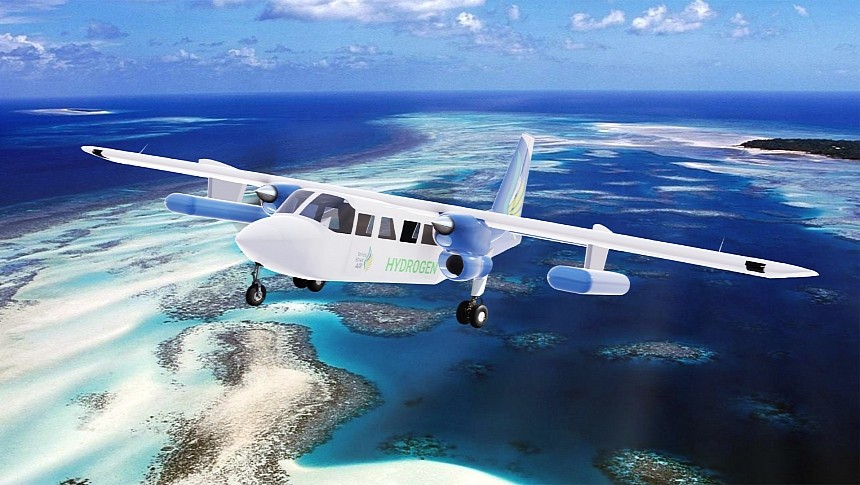On the way to zero-emission commercial flights, aviation operators in different parts of the world are betting on retrofitting solutions. The UK-based Cranfield Aerospace Solutions (CAeS) is one of the experts that can make this possible, and it joined forces with an Australian air charter company and a leasing company.
Torres Strait Air is a charter operator that wants to switch to a cleaner alternative. First, it will purchase ten new Britten-Norman Islanders, which are conventional regional aircraft. Next, Monte Aircraft Leasing will provide the financing required to modify them to run on hydrogen. More specifically, they'll be retrofitted with the hydrogen-electric propulsion system developed by CAeS.
The result will be a new ten-unit fleet that can reduce emissions by more than 70%. Monte is a key player in promoting this new approach to regional aviation. Last year, it agreed to purchase 40 conversion kits from CAeS. During the next phase, Monte is helping sub-regional operators with financing and leasing solutions so that they can switch to cleaner fleets.
CAeS was born at Cranfield University and became a trusted aviation player over the years. Its ultimate goal is to design and manufacture zero-emissions airliners. Still, that's going to take decades. That is why, as a first step, the UK-based company has developed a hydrogen-electric system for the conversion of the Britten Norman Islander.
This initial phase is formally called Project Fresson. The 9-seat Islander is converted from fossil fuel to gaseous hydrogen propulsion. The retrofitted version promises a range of 200 km (124 miles) and a 60-minute endurance (plus a 45-minute reserve). When entering service, the Hydrogen B-N Islander is set to become the world's first fully certified green passenger aircraft.
This year, CAeS focused on developing the first technology demonstrator after receiving significant funding (more than $8.5 million) from ATI (the Aerospace Technology Institute). It hopes to launch commercial operations by 2026.
The next step will be to develop conversion kits using liquid hydrogen for existing airliners. Liquid hydrogen promises better performance compared to the gaseous form, but it requires dedicated infrastructure, which makes it more costly in terms of time and money. CAeS plans to reach this stage before the end of this decade.
After 2030, Cranfield wants to focus on new aircraft design, starting with a 20-to-50-seat configuration and aiming for a standard airliner capacity of 50-to-100 passengers.
CAeS believes hydrogen to be "the most credible solution for aviation," and it's ready to prove it. The retrofitted B-N Islander will pave the way for a new generation of airliners that can operate with zero emissions. In the meantime, bold charter companies like the Australian Torres Strait Air are taking pioneering steps in renewing existing fleets with the help of conversion kits.
The result will be a new ten-unit fleet that can reduce emissions by more than 70%. Monte is a key player in promoting this new approach to regional aviation. Last year, it agreed to purchase 40 conversion kits from CAeS. During the next phase, Monte is helping sub-regional operators with financing and leasing solutions so that they can switch to cleaner fleets.
CAeS was born at Cranfield University and became a trusted aviation player over the years. Its ultimate goal is to design and manufacture zero-emissions airliners. Still, that's going to take decades. That is why, as a first step, the UK-based company has developed a hydrogen-electric system for the conversion of the Britten Norman Islander.
This initial phase is formally called Project Fresson. The 9-seat Islander is converted from fossil fuel to gaseous hydrogen propulsion. The retrofitted version promises a range of 200 km (124 miles) and a 60-minute endurance (plus a 45-minute reserve). When entering service, the Hydrogen B-N Islander is set to become the world's first fully certified green passenger aircraft.
This year, CAeS focused on developing the first technology demonstrator after receiving significant funding (more than $8.5 million) from ATI (the Aerospace Technology Institute). It hopes to launch commercial operations by 2026.
The next step will be to develop conversion kits using liquid hydrogen for existing airliners. Liquid hydrogen promises better performance compared to the gaseous form, but it requires dedicated infrastructure, which makes it more costly in terms of time and money. CAeS plans to reach this stage before the end of this decade.
After 2030, Cranfield wants to focus on new aircraft design, starting with a 20-to-50-seat configuration and aiming for a standard airliner capacity of 50-to-100 passengers.
CAeS believes hydrogen to be "the most credible solution for aviation," and it's ready to prove it. The retrofitted B-N Islander will pave the way for a new generation of airliners that can operate with zero emissions. In the meantime, bold charter companies like the Australian Torres Strait Air are taking pioneering steps in renewing existing fleets with the help of conversion kits.





